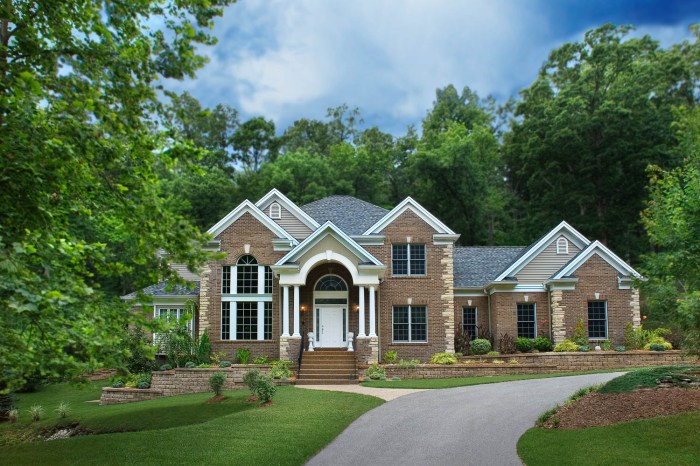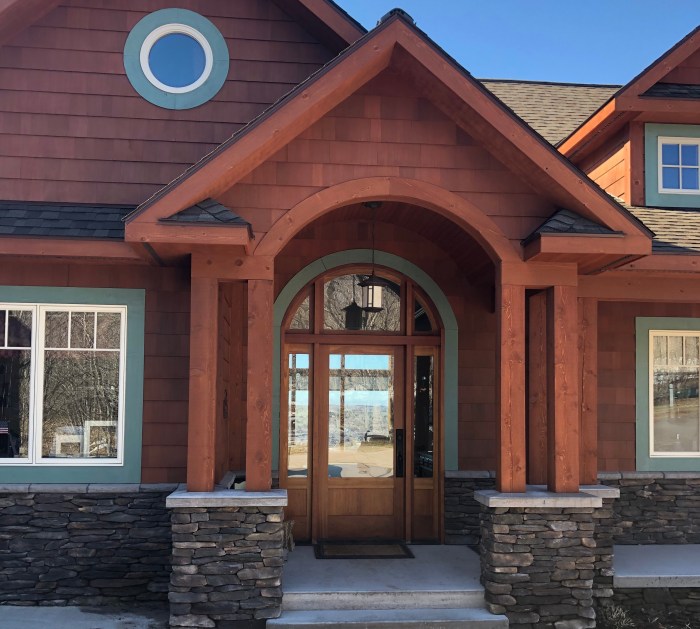Crafting Unique Exteriors: The Art of Customizing
Delve into the realm of custom exteriors, where innovation meets design to transform ordinary buildings into extraordinary creations. Discover how the fusion of aesthetics and functionality can elevate the charm of any property.
Explore the myriad possibilities that custom exteriors offer, from personalized touches to striking visual appeal, setting the stage for a truly unique architectural experience.
Overview of Custom Exteriors
Custom exteriors refer to the personalized design and construction of the outer appearance of residential or commercial buildings. This tailored approach allows property owners to create unique and visually appealing facades that reflect their style and preferences.Custom exteriors can enhance the aesthetics of a property by incorporating specific materials, colors, and architectural elements that complement the overall design.
For example, adding decorative stonework, wood accents, or custom windows can elevate the visual appeal of a building and make it stand out in its surroundings.In addition to aesthetics, custom exteriors can also improve the functionality of a property. Features such as strategically placed windows for natural light, energy-efficient insulation, or durable siding materials can enhance the comfort and sustainability of a building.
By customizing the exterior elements, property owners can create spaces that not only look great but also serve their practical needs effectively.
Examples of Custom Exteriors Enhancing Aesthetics and Functionality
- Installing a custom-designed entryway with unique architectural details can create a welcoming first impression for visitors and enhance the curb appeal of a property.
- Choosing energy-efficient windows and doors can improve insulation and reduce heating and cooling costs, contributing to the overall sustainability of the building.
- Opting for durable and low-maintenance exterior materials, such as fiber cement siding or metal roofing, can increase the longevity of the building and reduce the need for frequent repairs.
Materials for Custom Exteriors
Wood, vinyl, stucco, brick, and other materials are commonly used for custom exteriors. Each material has its own set of pros and cons in terms of durability, maintenance, and aesthetic appeal.
Wood
Wood is a popular choice for custom exteriors due to its natural beauty and versatility. However, it requires regular maintenance such as painting or staining to protect it from the elements. Wood is also susceptible to rot, pests, and warping over time.
Vinyl
Vinyl is low-maintenance and durable, making it a cost-effective option for custom exteriors. It comes in a variety of colors and styles, but it can fade or become brittle over time due to prolonged exposure to sunlight.
Stucco
Stucco is a durable material that can withstand harsh weather conditions and is fire-resistant. It offers a seamless, textured finish that can enhance the aesthetic appeal of a home. However, stucco can crack over time and may require regular maintenance to repair.
Brick
Brick is a classic choice for custom exteriors, known for its timeless appeal and durability. It requires minimal maintenance and can last for decades without needing replacement. However, the initial cost of using brick can be higher compared to other materials.
Design Elements in Custom Exteriors

When it comes to designing custom exteriors for buildings, several key design elements play a crucial role in creating a unique and personalized look. These elements include color schemes, textures, finishes, and architectural details, each of which contributes to the overall aesthetic appeal and individuality of the exterior.
Color Schemes
Color schemes are essential in custom exteriors as they set the tone and mood of the building. Whether opting for bold and vibrant colors or subtle and neutral tones, the choice of color can make a significant impact on the overall appearance.
It is essential to consider factors such as the building's surroundings, architectural style, and desired aesthetic when selecting a color scheme.
Textures
Textures add depth and character to custom exteriors, creating visual interest and tactile appeal. By incorporating different textures such as wood, stone, brick, or stucco, designers can enhance the overall look of the building. Textures also play a role in creating contrast and highlighting specific architectural features.
Finishes
Finishes, such as matte, glossy, or metallic finishes, can further enhance the design of custom exteriors. The choice of finish can impact the way light interacts with the building, creating unique effects and adding a touch of sophistication. Finishes also contribute to the durability and maintenance of the exterior over time.
Architectural Details
Architectural details, such as trim work, moldings, columns, and decorative elements, are vital in custom exteriors. These details add character, elegance, and charm to the building, showcasing the craftsmanship and attention to detail
Custom Exterior Features

When it comes to custom exterior design, there are various features that can be tailored to suit the homeowner's preferences and style. From siding to roofing, windows, doors, and more, each element plays a crucial role in creating a cohesive and visually appealing look for the home.
Siding
Siding is a key component of the exterior design, as it not only enhances the curb appeal but also provides protection against the elements. Homeowners can choose from a variety of materials such as vinyl, wood, fiber cement, or metal, each offering unique benefits in terms of durability, maintenance, and aesthetics.
Roofing
The roof is another important feature that can be customized to complement the overall design of the home. Different roofing materials like asphalt shingles, metal, tile, or wood shakes can be selected based on factors like durability, energy efficiency, and architectural style.
Windows
Windows not only bring natural light into the home but also contribute to its aesthetic appeal. Customizing windows in terms of size, style, and material can greatly enhance the overall look of the exterior while also improving energy efficiency and functionality.
Doors
Doors are not just entry points but also focal points of the exterior design. Customizing the front door with unique styles, materials, and finishes can create a welcoming and impressive entryway that sets the tone for the rest of the home's design.
Other Features
In addition to these main features, other elements like trim, landscaping, lighting, and outdoor structures can also be customized to add personality and character to the exterior. It is essential to integrate all these features cohesively to achieve a harmonious overall look that reflects the homeowner's style and preferences.
Budgeting and Planning for Custom Exteriors
Planning and budgeting for custom exteriors is crucial to ensure a successful and cost-effective project. By estimating costs, prioritizing expenses, and setting realistic expectations, you can achieve the desired results within your financial means.
Cost Estimation and Prioritizing Expenses
Before starting a custom exterior project, it is essential to determine the overall budget you are willing to allocate. Consider factors such as the size of the project, materials needed, labor costs, and any additional features you wish to include.
Research the average costs of similar projects in your area to get a better idea of what to expect.
- Estimate the costs of materials, labor, permits, and any unforeseen expenses that may arise during the project.
- Prioritize expenses based on what is most important to you. For example, if you value high-quality materials, allocate a larger portion of your budget to them.
- Consider the long-term maintenance costs of different materials to make informed decisions on where to invest your budget.
Planning Process for Custom Exteriors
The planning process for custom exteriors involves several key steps from conceptualization to execution. It is essential to have a clear plan in place to ensure the project runs smoothly and stays within budget.
- Conceptualization: Define your vision for the custom exterior, considering your personal style, architectural features, and functionality.
- Design Development: Work with professionals such as architects, designers, or contractors to create detailed plans and drawings for the project.
- Permitting: Obtain any necessary permits and approvals from local authorities before starting construction to avoid delays and potential fines.
- Execution: Hire experienced contractors and oversee the construction process to ensure the project is completed according to your specifications.
Final Conclusion
In conclusion, custom exteriors stand as a testament to the power of creativity in architectural design. With a careful blend of materials, design elements, and personalized features, each project becomes a masterpiece in its own right, leaving a lasting impression on all who behold it.
Question Bank
What are the common materials used for custom exteriors?
Common materials include wood, vinyl, stucco, brick, and more, each with its own unique characteristics.
How do design elements contribute to creating a unique exterior?
Design elements like color schemes, textures, and architectural details add personality and individuality to custom exteriors.
What features can be customized in exterior design?
Features such as siding, roofing, windows, and doors can be tailored to suit specific aesthetic and functional requirements.
What tips are essential for budgeting a custom exterior project?
Key tips include cost estimation, prioritizing expenses, and maintaining realistic expectations throughout the project.
What is the planning process involved in designing custom exteriors?
The planning process encompasses everything from conceptualization to execution, ensuring a cohesive and well-executed final result.




